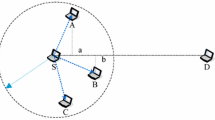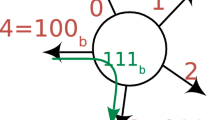Abstract
This paper presents a high-quality very large scale integration (VLSI) global router in X-architecture, called XGRouter, that heavily relies on integer linear programming (ILP) techniques, partition strategy and particle swarm optimization (PSO). A new ILP formulation, which can achieve more uniform routing solution than other formulations and can be effectively solved by the proposed PSO is proposed. To effectively use the new ILP formulation, a partition strategy that decomposes a large-sized problem into some small-sized sub-problems is adopted and the routing region is extended progressively from the most congested region. In the post-processing stage of XGRouter, maze routing based on new routing edge cost is designed to further optimize the total wire length and mantain the congestion uniformity. To our best knowledge, XGRouter is the first work to use a concurrent algorithm to solve the global routing problem in X-architecture. Experimental results show that XGRouter can produce solutions of higher quality than other global routers. And, like several state-of-the-art global routers, XGRouter has no overflow.
Similar content being viewed by others
Explore related subjects
Discover the latest articles and news from researchers in related subjects, suggested using machine learning.References
Chang Y J, Lee Y T, Gao J R, Wu P C, Wang T C. NTHU-route 2.0: a robust global router for modern designs. IEEE Transactions on Computer-Aided Design of Integrated Circuits and Systems, 2010, 29(12): 1931–1944
Roy J A, Markov I L. High-performance routing at the nanometer scale. IEEE Transactions on Computer-Aided Design of Integrated Circuits and Systems, 2008, 27(6): 1066–1077
Zhang Y, Xu Y, Chu C. FastRoute3.0: a fast and high quality global router based on virtual capacity. In: Proceedings of the 2008 IEEE/ACM International Conference on Computer-Aided Design. 2008, 344–349
Dai K R, Liu W H, Li Y L. NCTU-GR: efficient simulated evolutionbased rerouting and congestion-relaxed layer assignment on 3-D global routing. IEEE Transactions on Very Large Scale Integration Systems, 2012, 20(3): 459–472
Moffitt M D. Maizerouter: engineering an effective global router. IEEE Transactions on Computer-Aided Design of Integrated Circuits and Systems, 2008, 27(11): 2017–2026
Ao J, Dong S, Chen S, Goto S. Delay-driven layer assignment in global routing under multi-tier interconnect structure. In: Proceedings of the 2013 ACM International Symposium on International Symposium on Physical Design. 2013, 101–107
Ozdal M M, Wong M D F. Archer: a history-based global routing algorithm. IEEE Transactions on Computer-Aided Design of Integrated Circuits and Systems, 2009, 28(4): 528–540
Liu W H, Kao W C, Li Y L, Chao K Y. NCTU-GR 2.0: multithreaded collision-aware global routing with bounded-length maze routing. IEEE Transactions on Computer-Aided Design of Integrated Circuits and Systems, 2013, 32(5):709–722
Cho M, Pan D Z. BoxRouter: a new global router based on box expansion and progressive ILP. IEEE Transactions on Computer-Aided Design of Integrated Circuits and Systems, 2007, 26(12): 2130–2143
Albrecht C. Global routing by new approximation algorithms for multicommodity flow. IEEE Transactions on Computer-Aided Design of Integrated Circuits and Systems, 2001, 20(5): 622–632
Hu J, Roy J A, Markov I L. Sidewinder: a scalable ILP-based router. In: Proceedings of ACM International Workshop on System Level Interconnect Prediction. 2008, 73–80
Cho M, Lu K, Yuan K, Pan D Z. BoxRouter 2.0: a hybrid and robust global router with layer assignment for routability. ACM Transactions on Design Automation of Electronic Systems, 2009, 14(2): 32
Vannelli A. An interior point method for solving the global routing problem. In: Proceedings of the IEEE 1989 Custom Integrated Circuits Conference. 1989, 1–4
Behjat L, Chiang A, Rakai L, Li J H. An effective congestion-based integer programming model for VLSI global routing. In: Proceedings of Canadian Conference on Electrical and Computer Engineering. 2008, 931–936
Behjat L, Vannelli A, Rosehart W. Integer linear programming models for global routing. INFORMS Journal on Computing, 2006, 18(2): 137–150
Wu T H, Davoodi A, Linderoth J T. GRIP: global routing via integer programming. IEEE Transactions on Computer-Aided Design of Integrated Circuits and Systems, 2011, 30(1): 72–84
Han Y, Ancajas D M, Chakraborty K, Roy S. Exploring highthroughput computing paradigm for global routing. IEEE Transactions on Very Large Scale Integration Systems, 2014, 22(1): 155–167
Liu G G, Chen G L, Guo W Z. DPSO based octagonal steiner tree algorithm for VLSI routing. In: Proceedings of the 15th IEEE International Conference on Advanced Computational Intellligence. 2012, 383–387
Dong J, Zhu H L, Xie M, Zeng X. Graph Steiner tree construction and its routing applications. In: Proceedings of the 10th IEEE International Conference on ASIC. 2013, 1–4
Hung J H, Yeh Y K, Lin Y C, Huang H H, Hsieh T M. ECO-aware obstacle-avoiding routing tree algorithm. WSEAS Transactions on Circuits and Systems, 2010, 9(9): 567–576
Tsai C C, Kuo C C, Lee T Y. High performance buffered X-architecture zero-skew clock tree construction with via delay consideration. International Journal of Innovative Computing, Information and Control, 2011, 7(9): 5145–5161
Tsai C C, Kuo C C, Hsu F T, Lee T Y. Discharge-path-based antenn aeffect detection and fixing for X-architecture clock tree. Integration, the VLSI Journal, 2012, 45(1): 76–90
Liu G G, Guo W Z, Niu Y Z, Chen G L, Huang X. A PSO-basedtiming- driven octilinear Steiner tree algorithm for VLSI routing considering bend reduction. Soft Computing, 2014, 19(5): 1153–1169
Ho T Y. A performance-driven multilevel framework for the X-based full-chip router. Integrated circuit and system design. Power and timing modeling, optimization and simulation. Springer Berlin Heidelberg, 2009: 209–218
Hu Y, Jing T, Hong X, Hu X, Yan G. A routing paradigm with novel resources estimation and routability models for X-architecture based physical design. Embedded computer systems: architectures, modeling, and simulation. Springer Berlin Heidelberg, 2005: 344–353
Cao Z, Jing T, Hu Y, Shi Y, Hong X, Hu X, Yan G. DraXRouter: global routing in X-architecture with dynamic resource assignment. In: Proceedings of the 2006 Asia and South Pacific Design Automation Conference. 2006, 618–623
Ho T Y. A performance-driven X-architecture router based on a novel multilevel framework. Integration, the VLSI Journal, 2009, 42: 400–408
Teig S L. The X architecture: not your father’s diagonal wiring. In: Proceedings of ACM International Workshop on System-Level Interconnect Prediction. 2002, 33–37
Eberhar R C, Kennedy J. A new optimizer using particles swarm theory. In: Proceedings of the 6th International Symposium on Micro Machine and Human Science. 1995, 39–43
Neumann F, Witt C. Bioinspired computation in combinatorial optimization: algorithms and their computational complexity. Springer, 2010
Zhang Y, Gong D W. Generating test data for both paths coverage and faults detection using genetic algorithms: multi-path case. Frontiers of Computer Science, 2014, 8(5): 726–740
Rabanal P, Rodríguez I, Rubio F. An ACO-RFD hybrid method to solve NP-complete problems. Frontiers of Computer Science, 2013, 7(5): 729–744
Wang Y, Cai Z X. A hybrid multi-swarm particle swarm optimization to solve constrained optimization problems. Frontiers of Computer Science, 2009, 3(1): 38–52
Chen G L, Guo W Z, Chen Y Z. A PSO-based intelligent decision algorithm for VLSI floorplanning. Soft Computing, 2010, 14(12): 1329–1337
Guo W Z, Liu G G, Chen G L, Peng S J. A hybrid multi-objective PSO algorithm with local search strategy for VLSI partitioning. Frontiers of Computer Science, 2014, 8(2): 203–216
Koh C K, Madden P H. Manhattan or non-manhattan? A study of alternative VLSI routing architectures. In: Proceedings of the 10th Great Lakes symposium on VLSI. 2000, 47–52
Kennedy J, Eberhart R C. A discrete binary version of the particle swarm algorithm. In: Proceedings of the IEEE International Conference on Systems, Man, and Cybernetics. 1997, 4104–4108
Hu X, Eberhart R C, Shi Y. Swarm intelligence for permutation optimization: a case study of n-queens problem. In: Proceedings of Swarm Intelligence Symposium. 2003, 243–246
Parsopoulos K E, Halgamuge M N. Recent approaches to global optimization problems through particle swarm optimization. Natural Computing, 2002, 1(2-3): 235–306
Salman A, Ahmad I, Al-Madani S. Particle swarm optimization for task assignment problem. Microprocessors and Microsystems, 2002, 26(8): 363–371
Clerc M. Discrete particle swarm optimizationillustrated by the traveling salesman problem. In: Onwubolu GC, Babu BV: eds. New optimization techniques in engineering. Berlin: Springer-Verlag, 2004: 219–239.
Pan Q K, Tasgetiren M F, Liang Y C. A discrete particle swarm optimization algorithm for the permutation flowshop sequecing problem with makespan criteria. In: Proceedings of Research and Development in Intelligent Systems XXIII. 2006, 19–31.
Dietzfelbinger M, Naudts B, van Hoyweghen C, Wegener I. The analysis of a recombinative hill-climber on H-IFF. IEEE Transactions on Evolutionary Computation, 2003, 7(5): 417–423
Qian C, Yu Y, Zhou Z. An analysis on recombination in multi-objective evolutionary optimization, Artificial Intelligence, 2013, 204: 99–119
Alpert C, Tellez G. The importance of routing congestion analysis. In: Proceedings of the IEEE Design Automation Conference. 2010, 1–14
Shi Y H, Eberhart R C. A modified particle swarm optimizer. In: Proceedings of the IEEE International Conference on Evolutionary Computation. 1998, 69–73
Ratnaweera A, Halgamuge S K, Watson H C. Self-organizing hierarchical particle swarm optimizer with time-varying acceleration coefficients. IEEE Transactions on Evolutionary Computation, 2004, 8(3): 240–255
Lv H, Zheng J, Zhou C, Li K. The convergence analysis of genetic algorithm based on space mating. In: Proceeding of the 5th International Conference on Natural Computation. 2009, 557–562
Rudolph G. Convergence analysis of canonical genetic algorithms. IEEE Transactions on Neural Networks, 1994, 5(1): 96–101
Author information
Authors and Affiliations
Corresponding author
Additional information
Genggeng Liu is a PhD candidate in the College of Mathematics and Computer Science, Fuzhou University, China. His interests include computational intelligence and very large scale integration physical design.
Wenzhong Guo received his BS and MS in Computer Science from Fuzhou University, China in 2000 and 2003, respectively. He received his PhD in communication and information systems from Fuzhou University in 2010. He is currently a full professor with the College of Mathematics and Computer Science at Fuzhou University. His research interests include mobile computing and evolutionary computation. Currently, he leads the Network Computing and Intelligent Information Processing Laboratory, which is a key Laboratory of Fujian Province, China.
Rongrong Li is a MS candidate at the College of Mathematics and Computer Science, Fuzhou University, China. His interests include computational intelligence and very large scale integration physical design.
Yuzhen Niu received her BS and PhD in computer science from Shandong University, China in 2005 and 2010, respectively. She was a post-doctoral researcher with the Department of Computer Science, Portland State University, Portland. She is currently a professor with the College of Mathematics and Computer Science, Fuzhou University, China. Her current research interests include computer graphics, vision, and multimedia.
Guolong Chen received his BS and MS in Computational Mathematics from Fuzhou University, China in 1987 and 1992, respectively, and his PhD in Computer Science from Xi’an Jiaotong University, China in 2002. He is a full professor with the College of Mathematics and Computer Science at Fuzhou University. His research interests include computation intelligence, computer networks, and information security.
Rights and permissions
About this article
Cite this article
Liu, G., Guo, W., Li, R. et al. XGRouter: high-quality global router in X-architecture with particle swarm optimization. Front. Comput. Sci. 9, 576–594 (2015). https://doi.org/10.1007/s11704-015-4017-1
Received:
Accepted:
Published:
Issue Date:
DOI: https://doi.org/10.1007/s11704-015-4017-1




